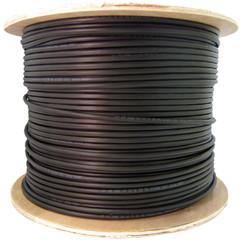How To Read Cable Jackets
The world of cables has many particulars. The engineering of a cable's electrical properties and its application are usually foremost in a consumer's thoughts when looking to purchase a cable. What's not as frequently considered is the material used to insulate the cable. This is known as the jacket. Knowing how to read cable jackets is essential. Most store-bought cables are expected to be used in a home or office, but when buying cables for a more particular use, the materials used in construction become more of a concern. Do you want to run a coax cable to your detached garage for a TV? Can you run a normal network cable in the plenum space in your office building? Is it legal to send different cable jacket types to my customer in Germany? We hope our answers to these questions, and more, will help make your next project a lasting success.
The information printed on a cable jacket will usually tell you everything you need to know. Typically this includes the manufacturer or UPC code, jacket material, any electrical standards it meets, temperature rating, and frequently a material rating that will tell you where the cable can be run in a building. Let's look at a common Cat-6 network cable as an example.

Click to Enlarge
 | CM - This is the material class for the cable. This is an example of a UL rating. A detailed explanation of UL ratings is given below. CM means this cable is made for general purpose. If this specified CMP or CMR, the cable would be suited for plenum or riser applications. |
 | 24 AWG (American Wire Gauge) - The individual conductors of this cable are 24 gauge. This does not indicate that the conductors are solid or stranded. |
 | 75 degrees Celsius - This does not mean that the cable will combust at this temperature, but rather the plastics used will slowly degrade if kept above this temperature for extended periods. |
 | Underwriters Laboratories - This is a standards body that oversees the design and manufacture of all kinds of products. It is not part of any federal code requirements, but is sometimes required by some companies for insurance purposes. |
 | The UL reference number relates to the manufacturer of this product. |
 | Canadian Standards Association - This is another standards body like UL, but is obviously more specific to Canadian installations. |
 | Just like the UL reference, the CSA reference number relates to the manufacturer. |
 | CMG - This is the rating of the fire retardant in the cable. |
 | Electrical Testing Laboratories - The standards body that verified this cable |
 | Verified - Indicates that this cable was verified by the afore mentioned body. |
 | TIA/EIA-568-b.2-1 - The coloring specification for the conductors inside this cable is in EIA-568-b revision 2-1 format. For network and phone cables, this lets you know which order to put the conductors in a crimp connector or to punch down to a block. |
 | CAT.6 - This of course indicates that this is a Category 6 network cable. Were this a coax cable, it would specify an appropriate standard like RG6, RG59 or RG59. |
 | Unshielded Twisted Pair - Twisted pair cables offer a simple form of shielding by twisting two conductors together down the length of the cable. The number of twists per inch (TPI) in networking cable is usually around 2 to 3 TPI, but this is up to the manufacturer. Category specifications like Cat 5 and Cat 6 do not define cable construction, only the electrical performance after manufacture. If this were shielded cable, this would say STP for Shielded Twisted Pair. Frequently cables will also specify the percentage of the shield. Coax cables can be anywhere from 60% to 99% shields, and frequently have several layers. Many satellite TV providers recommend "Quad Shield RG6". |
While this information is rarely in the same order on different types of cables, the material ratings have the same meaning.
UL Ratings
The Acronym UL stands for "Underwriters Laboratory." So what's this organization and what do they do? Underwriters Laboratory is an independent organization that tests thousands of products under controlled conditions. The goal is to determine in what applications these products are safe to be used. The end result is recognizable standards (such as CM - see above) that help consumers and businesses select products that they can reliably count on for their specific applications. A few ratings that are frequently encountered in cabling are:
-
CL-2 / CL-3
- This rating signifies the cable is intended for use with class-2 or class-3 circuits inside the walls of residential or commercial buildings. Most of our audio and video cables , including our HDMI cables , have this rating designation, something that becomes important if you're considering setting up a home theater where the cables will be run in-wall.
-
CM
- This rating signifies the cable is intended for general use within buildings.
-
CMX
- This rating signifies the cable can be used inside of buildings where the wire or cable is enclosed in a non-combustible conduit or raceway or in nonconcealed spaces where the exposed wire does not exceed 10 feet. This cable may also be used outdoors and anytime you're looking to run an outdoor setup CMX-rated cables should definetely be considered.
-
VW-1
- The VW-1 is a the name of the vertical flame test the UL uses to determine the flammability of the wire.
-
P Suffix
- Ratings ending in P designate that the cable jacket is plenum-rated as well allowing it to be used in plenum areas. Plenum-rated cables are more resistant to fire then normal cables. (Examples: CMP, CL2P) Plenum cables are extremely important if the area you're running cables through requires them (Usually determined by your local fire code). One reason why a plenum cable might be required would be that areas such as a plenum space serve as one of the main airways for buildings and burning PVC cable jacket material would pose a considerable health risk for the building's occupants.
-
R Suffix
- Ratings ending in R designate that the cable is intended for use in riser applications (vertical shafts) in residential or commercial construction. (Examples: CMR, CL2R)
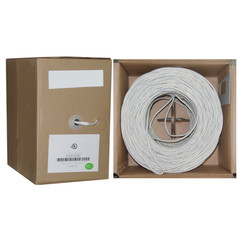
14/2 (14AWG 2C) 105 Strand/0.16mm Speaker Cable CL3 Rated
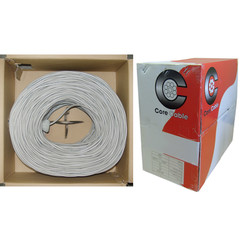
22/4 (22AWG 4C) Stranded CM Security Cable
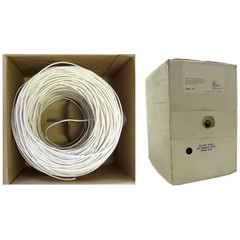
18/2 (18AWG 2C) Plenum Shielded Stranded CMP Security Cable, White
Jacket Material
The material the jacket of a given cable is made of is one of the most important features in defining where said cable can and can't be used. It's important not only in how physically durable the cable is but also how resistant it is to things such as fires. Some examples of materials are:
-
PVC
- This commonly used material's name stands for PolyVinyl Chloride. It's one of the most popular construction materials due to the fact it's relatively inexpensive to manufacturer and highly durable. PVC comes in many different versions (Example: Anti-UV PVC seen in outdoor rated cables).
-
CPVC
- Chlorinated Polyvinyl Chloride. This cable is similar to PVC however it can withstand much higher temperatures.
-
FEP
- Fluorinated Ethylene Polymer. One of the two plastics used in plenum cables along with a low-smoke version of PVC.
-
XLPE
- Cross-Linked Polyethylene. This is an alternative for PVC and is good choice for high-temperature applications.
-
LSZH
- Low Smoke Zero Halogen. This material is a good choice to use in situations where the smoke given off from cables catching on fire present health risks. When exposed to fire this cable will burn with very little smoke and no halogens.
Shielding
One of the most important considerations you can make when choosing a cable is selecting a cable with the appropriate shielding. If this decision is neglected it could lead to a poor signal or no signal at all. The culprit is electrical interference, electrical currents effect other nearby electrical currents and in the world of electronics this leads to unwanted performance degradation. The amount of shielding required will vary widely depending on what type of cable you're using but also your application. Examples of when shielding decisions are necessary includes:
- A Cat5 cable being used in your home vs. in a commercial server room.
- A coxial cable being used in your living room vs. be run into your home with your power cables.
- Another example would be if you're running a multimedia application over something like Cat5/6.
In general whenever your cables are in close proximity to power cables a shielded cable should be a consideration, especially when the cables are running parallel to each other. Some examples of shielding include:
-
Aluminum Foil
- This is a common type of shielding seen on anything from an RG6 coxial cable to a Cat6 cable . It is an excellent choice for deflecting electrical interference.
-
Copper Braiding
- Copper braiding is used in cables such as coaxial cables to provide shielding. It's typically expressed in the percent of coverage it provides (example: 95% coverage).

CAT6, STP (Shielded), 24AWG, Solid, 500MHz, Bulk Cable, Blue
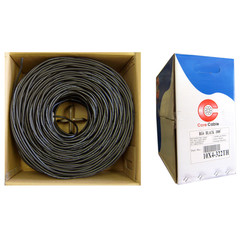
RG6 18AWG, Solid Pure Copper Coaxial Cable, 95% Copper Braid
Dielectric Insulators
Cables such as coaxial cables have a dielectric insulator. The primary responsibility of a dielectric insulator is to keep the wire in the center of the cable as well as keeping a distance between the wire and anything that may be able to cut or pierce the jacket. The dielectric insulator is usually made of polyethylene or polytetrafluoroethylene. In Cat 5 / Cat 6 cables that are shielded Mylar is used as an insulator. Mylar is a polyester film that is extremely strong with excellent insulation properties.
A good picture of a coaxial cable's dielectric insulator .
Outdoor Ratings/Direct Burial
Most cables are not inherently made to be used outdoors. A cable being exposed outdoors presents a few challenges which, if not addressed in the manufacturing of the cable, could lead to the long term failure of the cable. It's important to consider the following when looking at outdoor-rated cables :
-
Moisture Protection
- Being exposed to the elements the cable will most certainly encounter moisture. The cable must be manufactured to withstand moisture and continue working in damp or wet conditions. This becomes increasingly critical with direct-burial cable. Two commonly used solutions for moisture protection are waterproof tape or non-reactive gel, both increase the moisture barrier around the wires inside. Cables designed for this may also have a "-2" after their UL rating.
-
Temperature
- While all cables have a temperature rating this becomes a large concern with outdoor-rated cables. Outdoor rated cables will typically be more resistant to cold and heat than a non-outdoor rated cable. Outdoor-rated cables go through additional testing such as a cold-bend test where the cable will be kept at a temperature such as -20C for 4 hours while bent in a pre-determined radius. If the cable does not crack it passes. Still it is always wise to check the temperature ratings as there's a big difference between using the cable under a sheet of ice and using a cable on top of a metal room in New Mexico.

RG59 Siamese Coaxial Cable, Solid + 18/2 Power, Outdoor / Direct Burial, Black
Questions and Answers:
-
Question:
- Why do I have to use special cable just to run outside?
-
Answer:
- The jacket material of most cable is just a simple PVC (Polyvinylchloride). PVC will degrade in UV light (sunlight) and becomes brittle with dramatic changes in temperature. You may get through a season or two with a normal cable, but eventually it will fail. It's best to either use the correct type of cable, or run it in a metal conduit.
-
Question:
- Can outdoor rated cable be buried?
-
Answer:
- Generally, outdoor rated cable does not have enough of a moisture barrier to withstand being buried. It is possible for manufacturers to use an outdoor rated coating on a cable, and then fortify it with a waterproof tape to increase the moisture barrier and make it safe to put in the ground. Alternatively, some cable coatings can be buried without fortification (CMX). It is also common to fill the cable with a non-reactive gel to keep any water that make it through the jacket from spreading through the length of the cable.
-
Question:
- I'm running a network in an existing home and I have a particularly difficult run to make from the switch to the kitchen. I'd like to run the cable in a heating duct. Will a normal network cable do the trick?
-
Answer:
- Not quite, a heating duct is a plenum space and a plenum rated cable would be required. If you're traveling between floors, you'll have to use a riser rated cable (CMR). Also, check with your local building department for the regulations on putting holes into a plenum box.
-
Question:
- My woodworking shop is in a detached garage about 150 feet from my home, and I'd like to run network and phone line out there. What should I use?
-
Answer:
- While a good argument could be made for a wireless solution, you have two cabling options. Either you can run a conduit and run your cables inside, or bury the cables directly. Burying the cable directly is faster and usually cheaper, but if you run a conduit you can add cables to it later if you need to. No matter what your choice, be sure to use solid core cable. It conducts better over longer distances.
-
Question:
- Can I include a cable a with a product I ship to Europe?
-
Answer:
- Yes! However, quite soon it will be important to make sure the product meets the requirements of the ROHS (Restriction of Hazardous Substances) directive. We currently offer a large selection of ROHS compliant products.


